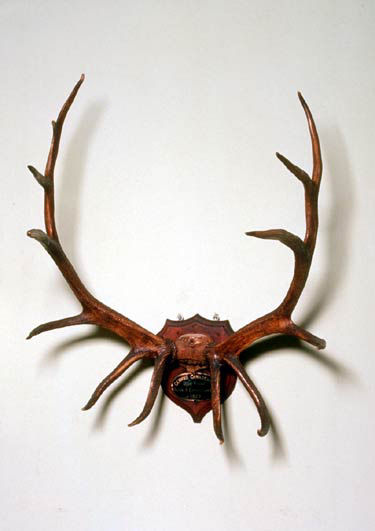Jefferson Prepares for the Lewis and Clark Expedition
Reading Level: Middle School

This set of Elk Antlers is one of the few surviving natural history specimens sent back from the Lewis and Clark Expedition
Jefferson plans for the Expedition
Long before he became the third president of the United States, Thomas Jefferson had dreamed of sending explorers across North America. When Jefferson took office in 1801, most of the United States population lived within 50 miles of the Atlantic Ocean. Knowledge of the western part of the continent was limited to what had been learned from French traders and fur trappers and Spanish and British explorers. On January 18, 1803, President Jefferson sent a secret letter to Congress asking for $2,500 to fund an expedition to the Pacific Ocean. He hoped to establish trade with the Native American people of the West and find a water route to the Pacific. Jefferson also was fascinated by the prospect of what could be learned about the geography of the West, the lives and languages of the Native Americans, the plants and animals, the soil, the rocks, the weather, and how they differed from those in the East.
Captain Meriwether Lewis
President Jefferson’s choice to lead an expedition was Meriwether Lewis, his former secretary and a fellow native of Albemarle County, Virginia. Having reached the rank of captain in the U.S. Army, Lewis possessed military discipline and experience that would prove invaluable. While in the Army, Lewis had served in a rifle company commanded by William Clark. It was Clark whom Lewis chose to assist him in leading this U.S. Army expedition, commonly known today as the “Corps of Discovery.” On February 28, 1803, Congress appropriated funds for the Expedition, and Jefferson’s dream came closer to becoming a reality.
Education in Philadelphia
It was important for Lewis to gain certain scientific skills and to buy equipment that would be needed on the journey. In the spring of 1803, Lewis traveled to Philadelphia to study with the leading scientists of the day. Andrew Ellicott taught Lewis map making and surveying. Benjamin Smith Barton tutored Lewis in botany, Robert Patterson in mathematics, Caspar Wistar in anatomy and fossils, and Benjamin Rush in medicine.
Gifts for the Native Americans
Lewis also purchased gifts for Native Americans. It was well known that in Indian cultures gift exchange was an important sign of friendship and allegiance. To prepare for this, he bought glass beads, mirrors, scissors, thimbles, needles, tobacco, knives, and peace medals. Through the exchange of gifts, and following Jefferson’s instructions to treat the Indians “in the most friendly and conciliatory manner,” it was hoped that knowledge of them could be acquired and trade increased.

This map shows the boundaries of the Louisiana Purchase as recognized today.
Captain Lewis sets off
While Lewis was back in Washington in July 1803, the United States’s purchase of the Louisiana territory from France was announced. Now the journey was even more important. Lewis and his party would be exploring land that belonged to the United States. Armed with Jefferson’s letter of instructions, Lewis traveled to Pittsburgh and then set out on the Ohio River. At Clarksville, in present-day Indiana, he met up with William Clark. They packed the keelboat, which Lewis had designed, and two pirogues (canoe-like boats) with supplies and headed downriver. They were accompanied by some recruited soldiers, Clark’s African-American slave York, and Lewis’s Newfoundland dog Seaman.

